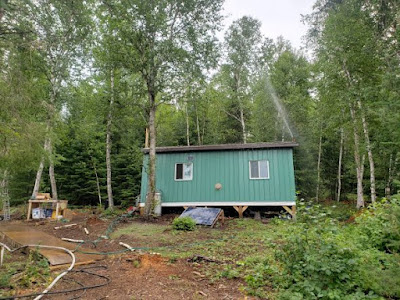 |
| For sprinklers, attach pump to a large gas tank that will last days |
We started planning for our cabin five years ago by buying a fire pump. It wasn't just a hedge against climate change but a tool that we would never think of being without in the Boreal Forest. We are in a sea of fuel and it can only take a spark to set it off. That spark could accidentally come from us -- from a chainsaw or other machine. And, of course, it could come from a lightning strike. The pump isn't for fighting a major forest fire; it's for preventing a little blaze from becoming an inferno.
 |
| Sprinklers at work on our dockhouse |
We set up our pump on the dock as soon as we get to the cabin in the spring. I pile the hoses on top and cover the whole works with a plastic garbage can to keep everything dry. If the weather gets hot and dry I attach the hoses and stretch them out with the nozzle on the end hose. If we're past danger of frost I go ahead and prime the pump. We can be spraying hundreds of gallons of water a minute with one pull of the recoil rope.
After the fire flap of last summer we also have added a sprinkler system. We have two sprinklers on the gable end of each building. These are attached to garden hoses that are in turn attached to a fire hose fitting called a water thief. This fitting goes between the lengths of the canvas fire hose and has two places to attach the garden hoses. A handy configuration is to have 50-foot lengths of fire hose and 50-foot lengths of garden hose.
When we fire up the pump the rotating sprinklers soak everything for about 50 feet around the buildings. It would be best if there were no large trees in that radius, especially conifers. It will be years before we achieve that but in the meantime the sprinklers give us some chance of surviving a forest fire.
During our years in the camp business we were fortunate to get some fire survival tips from NOTO, our industry organization that held an annual conference and trade show. A group called FireSmart had some eye-opening videos of how cabins ignite from forest fires. It happens well in advance of the actual fire. Embers from the main blaze come blowing along the ground at great speed caused by the wind that the fire generates ahead of itself. These glowing bits of wood go beneath the cabins and build up in the floor joists. If there is firewood or lumber piled down there then the embers ignite that as well.
They also hit the walls of the cabin and are funneled by the wind into the eaves and gables. They accumulate there like a glowing pile of barbecue briquets until the building ignites.
The lesson here is to enclose your buildings with skirting all the way to the ground and with metal fascia on the eaves and gables.
This is what we are doing on our cabins and shed. And as an added precaution we are using steel siding and roofing as well.
 |
| Here's what it is like to live near two half-million acre fires. It's 3 o'clock in the afternoon on what would have been a bright sunny day except for the dense smoke |

2 comments:
With so much at risk, it's great to have a plan like you do. How do you prevent clogs when you might need to pump so much water so quickly?
There is a screen on the suction hose in the lake. This end actually has a canister with screen all around. Lots of surface area in a 360-degree shape. As long as you put it where there is clear water, it should never plug.
Post a Comment